The School Days anime aired in Japan for 12 episodes in 2007. The series, which was based on an adult visual novel of the same name, achieved meme status due to its horrendously unlikable protagonist, bloody ending, and the peculiar circumstances around the airing of its last episode. Shortly before the final episode of School Days was set to air, a real-world story of a murder in Japan was uncomfortably close enough to the events of the upcoming anime episode that the episode was delayed. The last episode of School Days was replaced on air by a collection of scenic video clips set to relaxing music. One of the scenes was of a nice boat on a river in Denmark. The dark humor of the situation in conjunction with the fact that the yet-to-air final episode of School Days concluded on a similar-looking boat spawned “nice boat” as an internet meme. In this article, I review the School Days anime in a comprehensive and spoiler-filled manner, offer my generally negative impression of the series, and explain the infamous nice boat meme. I will also explain how a post by my New Leaf Journal colleague Victor V. Gurbo on Love Henry, a classic folk ballad, inspired me to subject myself to re-watching School Days for the purpose of writing the instant article.

Spoiler Warning: I will spoil the dramatic events of School Days in this post. School Days is a bad anime. I watched it so you do not have to. But if you insist on watching School Days before seeing spoilers, consider this your fair warning. It is available in English on Crunchyroll.
May 7, 2022 Update: I published a follow-up article on May 6, 2022, with a different look at the episode behind the Nice Boat meme. (See follow-up article.)
July 8, 2022 Update: I published a humorous post on the two heroines of School Days becoming VTubers.
September 20, 2022 Update: I re-wrote the introduction to this article and moved my section on how Victor inspired me to write the post to the bottom of the content. The Love Henry section received mild edits to reflect its appearing below my School Days review instead of above it. I made these changes in the hope of bringing more readers to this post. It receives a relatively (by our standards) high number of search engine impressions but a low number of conversions. I hope that a more descriptive introduction in conjunction with moving the actual School Days content higher in the order of the article will lead to more people discovering the review.
A Brief Overview of School Days
The School Days anime is based on a visual novel of the same name. School Days the visual novel was originally released in Japan for Windows in 2005. The anime series ran two years later in 2007.
The School Days visual novel was an “eroge” visual novel, meaning it had scenes with sexual content. The anime does not have sex scenes or nudity, although impure conduct does occur off-screen.
I have never played – and will never play – the visual novel, so my direct knowledge of School Days is solely of the anime series. What I know about the visual novel comes from secondary sources.
Like many visual novels, School Days had multiple endings. Unlike multi-path visual novels we have reviewed at The New Leaf Journal such as Bad End and LoveChoice, School Days had a large number of wildly divergent endings – generally turning on which female character (or characters) the protagonist, Makoto, ends up with. Indulge me for a moment as I offer a note on adapting multi-path visual novels into anime.
Adapting Multi-Path Visual Novels Into Anime
Anime series tend to be of limited duration. School Days had twelve episodes to work with. In light of the fact that the game had about 20 endings, many of which not at all similar, the anime team had to make a choice of which story, or stories, to adapt.
Adaptations of multi-path visual novels are not uncommon, and there are different ways of handling them.
- Hard Omnibus Format – Break the anime into separate and distinct arcs covering different paths from the visual novel (Example: Sentimental Graffiti).
- Hybrid Omnibus Format – Have the anime ultimately cover one route of the visual novel, but have arcs in the story that address alternative routes in the context of the main route (Example: Clannad; Kanon (2006))
- Single Route Only – Faithfully adapt one route of the visual novel and exclude the others (Example: Fate/stay night [Unlimited Blade Works]).
- Change the World – Alter the source material to make it more conducive to the anime medium (Example: KimiKiss Pure Rouge).
School Days’ Adaptation Style
The vast majority of the School Days visual novel endings are non-violent. That is, the protagonist – Makoto Itou – ends up with one or more of the heroines and no blood is shed. The game was well-known, however, for having a small number of violent endings focusing on a love triangle between Makoto and two of the girls – Kotonoha Katsura and Sekai Sainoji.
Most adaptations of dating sims opt for adapting the “true” ending, or at least a happy ending. School Days took the path less traveled – adapting the most disastrous, violent, and worst ending it could find.
In full disclosure, I do not know if the bad ending in the School Days anime exactly matches one of the several bad endings in the visual novel. That is, while the original bad endings involved murder in the main love triangle, the anime versions of them may not be exactly the same as the visual novel. My impression is that it is a composite ending, borrowing from the multiple bad endings in the visual novel.
The Story of School Days
School Days is a strange show. There is little to suggest that School Days will be more than a somewhat angsty high school love triangle melodrama for the better part of the first four episodes. Things start to turn dark when two parties in the main love triangle betray the unsuspecting third party by engaging in carnal relations. The transcendently horrible protagonist would then transcend the love triangle, engaging in licentiousness with nearly every girl in the school (so it seemed) before the love triangle finally reached its bloody conclusion.
Let us begin.
Starting Notes
Do note that I have not actually watched School Days in full since I watched it 10-11 years ago. While I am committed to delivering only the most accurate content here at The New Leaf Journal, I have neither the time nor the inclination to devote more than four-and-one-half hours of my life to re-watching School Days in its entirety. For that reason, I relied on Wikipedia episode summaries to refresh my memory of the “plot” and re-watched a few key scenes to check my work and add detail.
Because this is, as Victor is wont to say, a “family website” – I will use a cornucopia of unnecessary euphemisms in summarizing the plot of School Days.
The Main Love Triangle
The main love triangle consists of three characters – all first-year high school students:
- Makoto Itou (boy)
- Kotonoha Katsura (girl)
- Sekai Sainoji (girl)
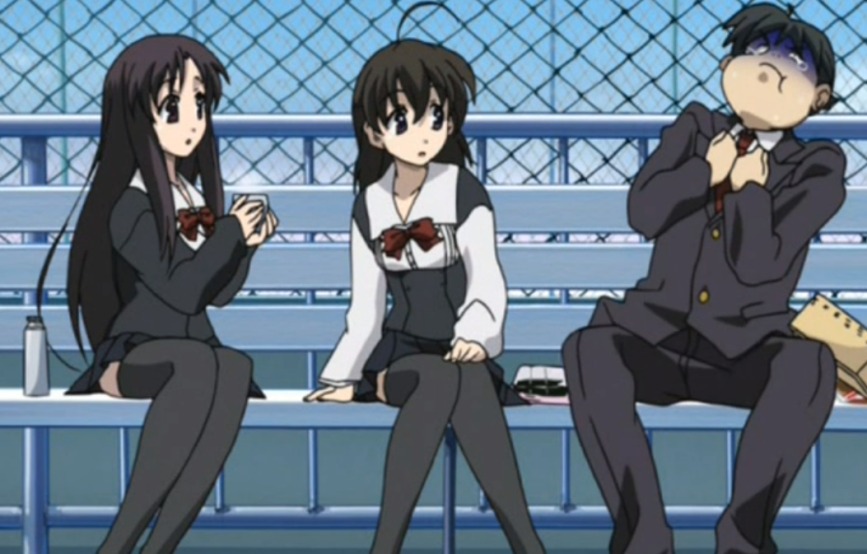
At the beginning of the show, all three characters are unassuming. Makoto is a bland, ordinary looking boy with a crush on Kotonoha. Kotonoha is a quiet, reserved girl. Sekai is an energetic girl with a crush on Makoto.
While Makoto sleeps with almost every single girl with any lines in the story, one additional character is significant in the middle of the show. Sekai’s best friend, Setsuna Kiyora, was the one who had loved Makoto the longest – well before he was on Sekai’s or Kotonoha’s radar. Her actions to help Sekai toward the middle of the show did not help anyone, much less her when she proved unable to control her feelings. While it was obvious that Setsuna would not be the “winner” of Makoto’s affections, I suppose she temporarily made the show a love square.
Brief Overview
Makoto, an unexceptional high school student with no redeeming qualities, has a crush on Kotonoha. Sekai, who has a crush on Makoto, “helps” Makoto talk to Kotonoha. She succeeds, and Makoto manages to ask Kotohona out – Kotohona accepts. In a sign of things to come, Sekai kisses Makoto to “congratulate” him and wishes him luck. What are friends for?
Makoto and Kotohona do not make a great couple, but with some help from Sekai, things start going down the right path. Just as the relationship is picking up, Makoto tells Sekai that he is tired of Kotohona. He begins trying to push his luck with Kotonoha, but she tells him that she is not ready. Makoto complains to Sekai, who offers to “teach” him. Shockingly, these lessons increased in intensity and frequency.
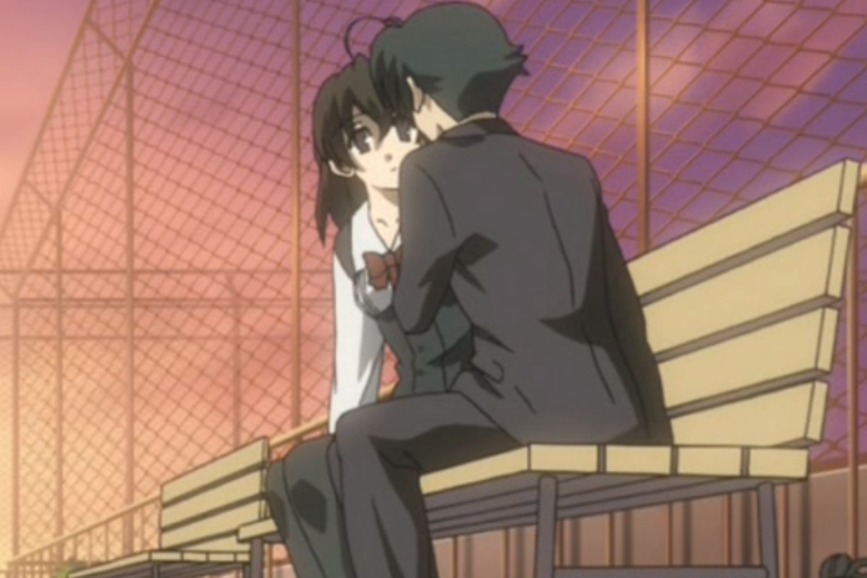
Then, yada yada yada, Makoto and Sekai woke up together in Sekai’s apartment after they spent a long time together.
(Victor will approve of my Seinfeld reference in the above link.)
The Love Triangle Begins
Makoto and Sekai continued with their postgraduate lessons, but Makoto refused to actually break up with Kotonoha – opting to ignore her instead. Sekai, having a tiny-bit more conscience than Makoto, felt a touch guilty about her behavior, but not enough to stop. Kotohona – now having transitioned from being ambivalent about her new boyfriend to completely obsessed to the point of being mentally broken, refused to take a hint when she twice saw Makoto and Sekai together behaving like a couple.
Setsuna Kiyora, Sekai’s best friend who was also in love with Makoto, was under the impression that Makoto and Sekai were dating (questionable), that Makoto had broken up with Kotonoha (false), and that Kotonoha was endangering his relationship by not giving it up (true if you are wearing the right glasses). She took actions into her own hands, telling people that Makoto had broken up with Kotonoha and forcibly deleting Kotonoha’s number from Makoto’s phone.
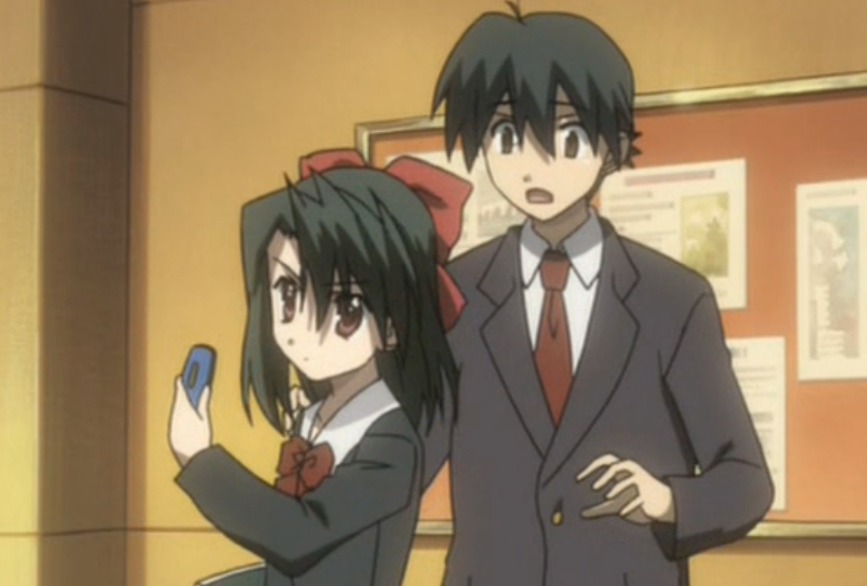
Kotonoha did not take the hint when her calls could no longer get through. She visited Makoto and apologized for her phone not working. Makoto insisted it was his phone that was broken and surreptitiously unblocked her number. Makoto then half-heartedly agreed to dance with Kotonoha at the upcoming school festival. Kotonoha left. Sekai, who had been hiding in the other room, was distressed and ran outside. Little did she know that Kotonoha had noticed her shoes in Makoto’s doorway. Kotonoha waited outside for Sekai and slapped her.
At least Kotonoha partially recognized reality. Partially.
The School Festival Begins
Things had been going well thus far, but they took a turn for the worse at the school festival.
Setsuna was concerned when Sekai did not show up to school. She pressed Makoto on his feelings – Makoto insisted that he preferred Sekai to Kotonoha (I venture that he no longer liked either). Later that day, Makoto fell asleep. Setsuna took her chance to kiss the sleeping monster. Kotonoha happened to see them and asked Setsuna how Sekai would feel. Setsuna brushed away the implied threat by explaining that she was leaving for France soon and wanted one memory of Makoto to take with her.
Who would not want a special memory of one of fiction’s greatest monsters?
On day two of the festival, Makoto finally chose a girl. His long-time classmate going back to middle school, Otome Kato, convinced Makoto to go into a storage closet with her where they acted in a somewhat impure manner. After that, an unknowing Sekai took Makoto back. Makoto danced with Sekai at the festival, having forgotten his promise to Kotonoha. Kotonoha saw Makoto and Sekai and turned into a lifeless doll, animate – but with no one home. A cad who was an even bigger monster than Makoto (hard to believe, I know), took advantage of Kotonoha’s semi-lifeless condition, and Kotonoha betrayed no signs of life in her open-but-dead eyes.
The First “Break-Up”
While things had been alright to this point, they took a dramatic turn for the worse on day two of the festival.
The cad who took advantage of Kotonoha then asked her on a date, presenting two tickets for an amusement park, movie, or something to that effect. Kotonoha coldly rejected him, telling him that she was with Makoto, and that what happened the day before meant nothing.
This caused more rumors about Makoto and Kotonoha to spread. Setsuna, worried that her dear friend may lose her relationship with an actual lizard-person, revealed to Makoto that she was moving to France and forced him to promise that he would take care of Sekai. They ran into Kotonoha, who talked to Makoto as if nothing at all had happened. Makoto was prepared to avoid conflict as he usually did, but Setsuna forced him to break up with Kotonoha.
It was a real shock when Kotonoha refused to accept Makoto’s decision – correctly identifying Setsuna as being behind it. Kotonoha retaliated by revealing Setsuna’s feelings for Makoto. Unperturbed, Setsuna admitted it – kissing Makoto in front of Kotonoha and forcing Kotonoha to accept Makoto’s rejection.
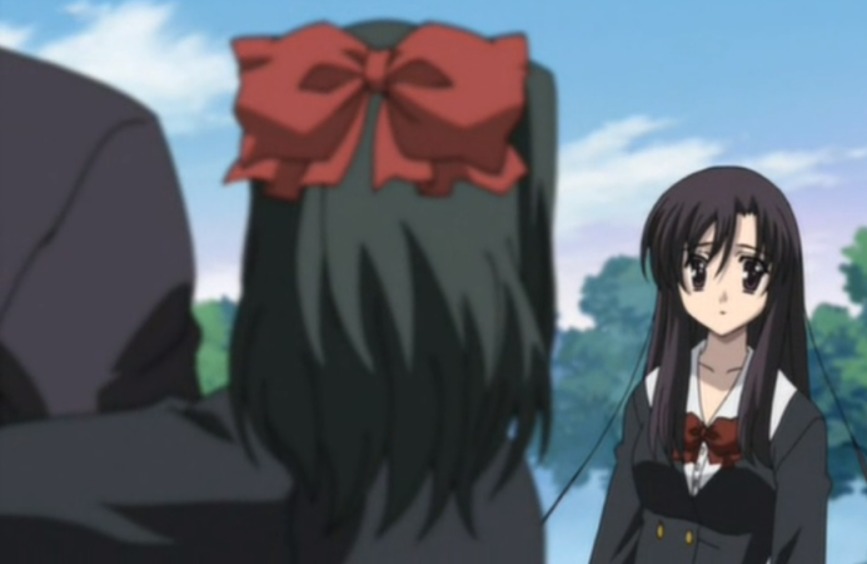
In a significant point, however, Setsuna also told Kotonoha that she would be with Makoto the next day.
Kotonoha, who could no longer deny reality, lost her last spark of life and turned into a zombie.
Sekai’s and Setsuna’s Failures
You may be thinking that things have not gone too poorly yet. But I am sad to say that this is where things would take a wrong turn.
Setsuna hoped that she had resolved matters for Sekai. However, after school, Sekai could not find Makoto. She left and Setsuna set out to find Makoto. She found that Makoto was in the storage closet with Otome again.
Setsuna was furious that Makoto had gone back on his promise in about five minutes. It was, unknown to him, her last day in Japan. Setsuna visited Makoto that evening to confront him over his behavior – and demanded that he break up with Otome and be loyal to Sekai. Makoto defied his entire characterization by moving on Setsuna, taking advantage of the fact that she was in love with him. Setsuna had probably expected as much, and was not unreceptive, but she conditioned their making the beast with two backs on Makoto’s promising that he would thereafter be loyal to Sekai.
The next morning, Setsuna left Makoto’s apartment without telling him and went straight to the airport. Makoto was distraught and went searching for Setsuna, who was already en route to France.
Sekai, on the other hand, was at school. Because they went to the most creepy and morally degenerate school on Earth, Sekai discovered, to her horror, that the girl’s basketball team had set up a camera in the storage closet during the festival. She was less than pleased when she discovered video of Makoto and Otome. Makoto was no longer picking up his phone, so Sekai went to find him. She found a lifeless Kotonoha instead – Kotonoha said that Makoto said he would be with Setsuna. Sekai could not get in touch with Setsuna either – which makes sense since Setsuna was on her way to France.

Makoto Goes From Unimaginably Bad To Unimaginably Bad
You may be thinking that Makoto has not been the best person to this point. That may be true, but this is where he really took a turn toward darkness.
Sekai stopped going to school. Kotonoha remained an empty husk. But life was never better for Makoto. He had now acquired a reputation for pure and virtuous behavior among many classmates at his school, and they began indulging his immaculate reputation. Among them was Hikari Kuroda, another one of Sekai’s friends. Then Makoto was being visited by more than one young lady at the same time – surely to pick his brain about the upcoming exams.
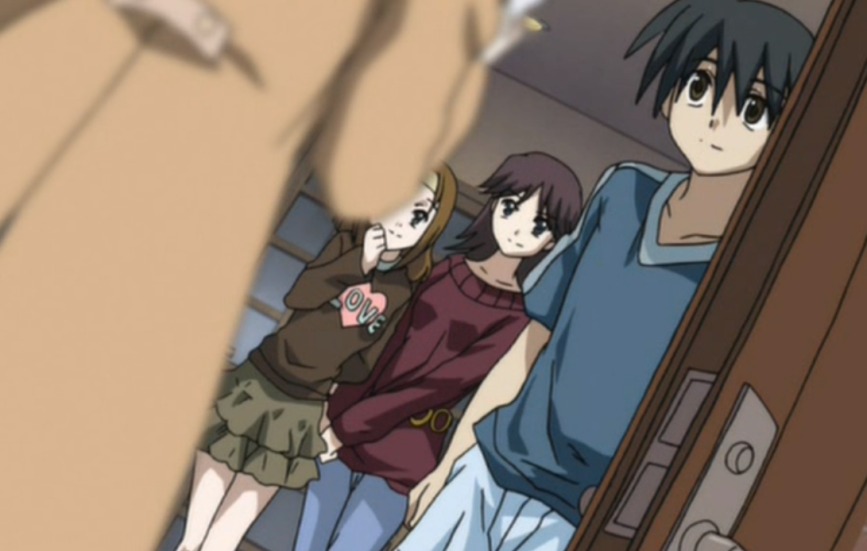
Sekai decided that she was pregnant – although we are never given any concrete reason to believe that she was actually pregnant. In any event, she showed up at school and confronted Makoto in front of everyone. This was apparently too much for everyone at school – and all of Makoto’s new female companions stopped returning his calls.
What did they think of him before? Well, whatever.
Makoto, now left without any woman, began staying with Sekai. He was not happy about this state of affairs, however. Makoto ran into the empty vessel that once housed Kotonoha, and having been abandoned by everyone, broke down and apologized to her, insisting that he had been wrong and she was the one he loved.
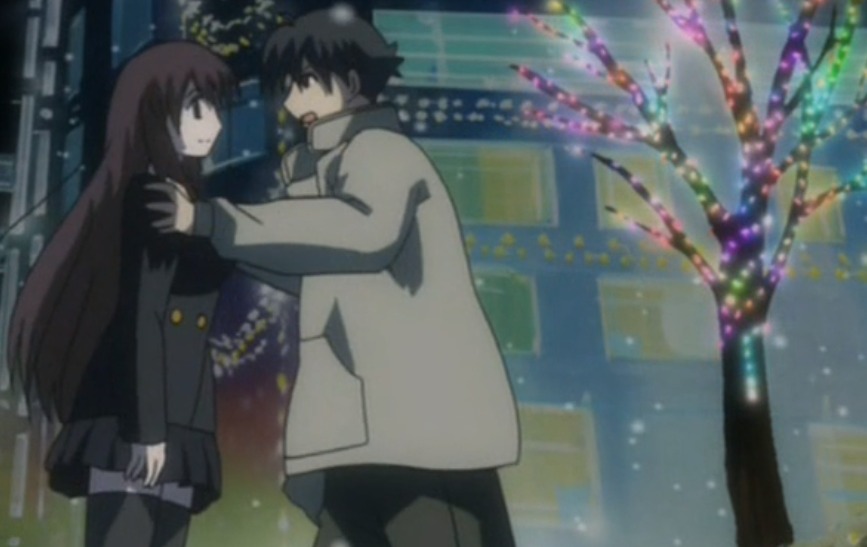
Kotonoha told the cad to take a hike.
Did I have you going for a second?
Life returned to Kotonoha’s. She was overjoyed. She finally won.
It Actually Gets Worse
While the show had depicted a sentimental high school experience before this point, things would take a rather sudden and fatal turn.
Having decided that Kotonoha was the only young woman for him, Makoto cut off Sekai. Sekai caught Makoto and Kotonoha together and then decided to confront them. Kotohona won the face-off decisively by revealing everything Setsuna had felt and done before kissing Makoto. Sekai was displeased. Makoto, always ready to take responsibility, told Sekai that she should get an abortion and forget about him.
What a guy!
Sekai decided to see Makoto one more time. Instead of trying to win him back, however, Sekai stabbed Makoto to death with a kitchen knife after cryptically apologizing for the impending deed to him over text.
Sekai fled. Kotonoha returned to Makoto’s apartment to find him dead. She had suspicions about the identity of the culprit. Kotonoha send a text message to Sekai instructing her to meet on the school roof. There, they faced off. Like any normal person, Kotonoha brought Makoto’s head with her.
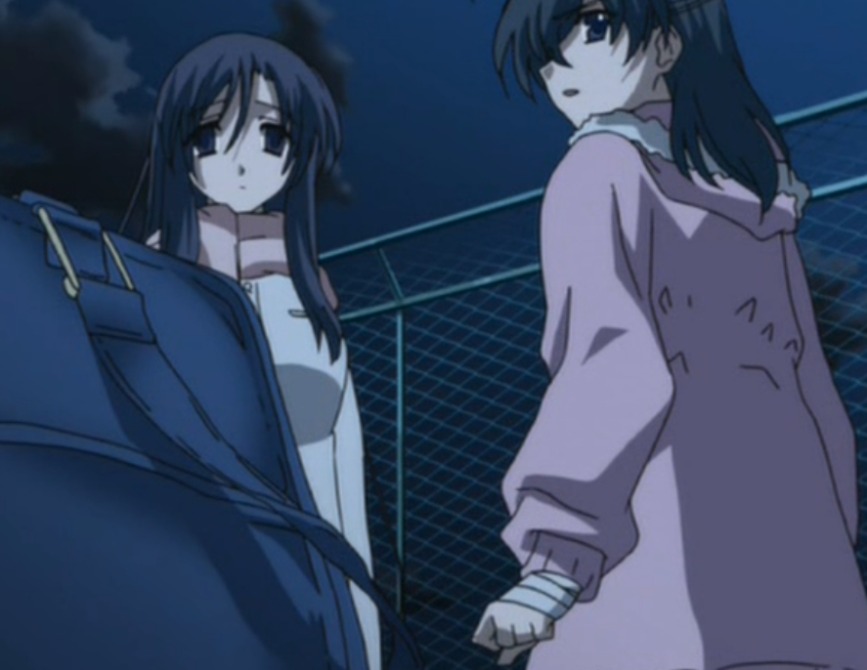
Sekai realized just a bit too late that Kotonoha was just a bit crazier than she was. Worse yet for Sekai, Kotonoha had been hiding ninja-like speed and reflexes the entire show – she struck first and last, murdering Sekai on the roof top and “confirming” that Sekai had been lying about being pregnant.
Nice Boat
After all the events of School Days, Kotohona and Makoto finally found peace together.
The show ended with Kotonoha cradling Makoto’s head on a boat.
I know what you must be thinking.
Fear not.
School Days foreshadowed the boat in episode 10 when Kotohona mentioned it in her confrontation with Makoto and Setsuna.
Chekhov’s gun fired.
(The knife with which Sekai stabbed Makoto had also been foreshadowed around the same time as Kotohona’s boat, but I forgot to note the specific episode.)
A Review of the School Days Anime
It should be obvious from the description that School Days is a literary and artistic failure with no significant positive equities. Not even out-of-story factors saved it: The animation quality and soundtrack were average for a 2007 anime.
But to note that School Days is bad is not interesting. Below, in several sections, I will explain precisely why I think School Days ended up being a disaster.
On Rotten and Irrational Characters
There is no doubt that School Days features a remarkably rotten set of characters. Of the significant characters, only Kotonoha and Setsuna are not entirely irredeemable.
That a work of art – be it an anime series, movie, book, or song – features rotten characters doing terrible things does not, in and of itself, make it a bad work of art. Little suggests the characters of Love Henry or Frankie and Albert were upstanding individuals, but Victor made a strong case in his articles about both that the songs and stories as a whole had aesthetic merit.
Nor does characters behaving poorly necessary render a work of art worthless. Two sub-recommendations from by Anime Recommendations from 2011-2020 list – White Album 2 and Flowers of Evil (scroll down if you follow the links to White Album 2 and Flowers of Evil), featured some combination of warped characters and very irrational behavior. Both of those shows were good, in part because they were well-written and conceived (I will note White Album 2 had a sympathetic cast). White Album (not directly related to White Album 2) had the closest thing to a Makoto-like protagonist outside of School Days itself – but it at least made an effort to explain his behavior.
School Days is not a mess because it is a show about generally awful people behaving in terrible ways. It is a mess because it is poorly written and structured.
The Behavior of the Characters Was Not Believable
As Victor established with respect to Love Henry, a lover’s descent into madness is a timeless theme that can be done well. The work of art must, however, give a believable, credible account of the descent. Love Henry – being a short song – is razor focused on its theme. We know little about the couple other than the man’s plan to leave his lover and her brutal response – but in this short story – it tells a believable tale.
Shakespeare’s Othello is a timeless example of a carefully structured story explaining a character’s descent into murderous behavior.
School Days is simply not believable. The behavior of Makoto, Kotonoha, and Sekai, and their descent into madness throughout the show, is not credible. I shall explain.
Failure to Provide Credible Account of Kotonoha
At the start of the show, Makoto has an ordinary crush on Kotonoha. When they first date, Makoto clearly has more interest than Kotonoha. After he ruined the first date by trying to kiss her, Makoto genuinely wanted advice on how to make things right, and Kotonoha had to be convinced to give Makoto another chance.
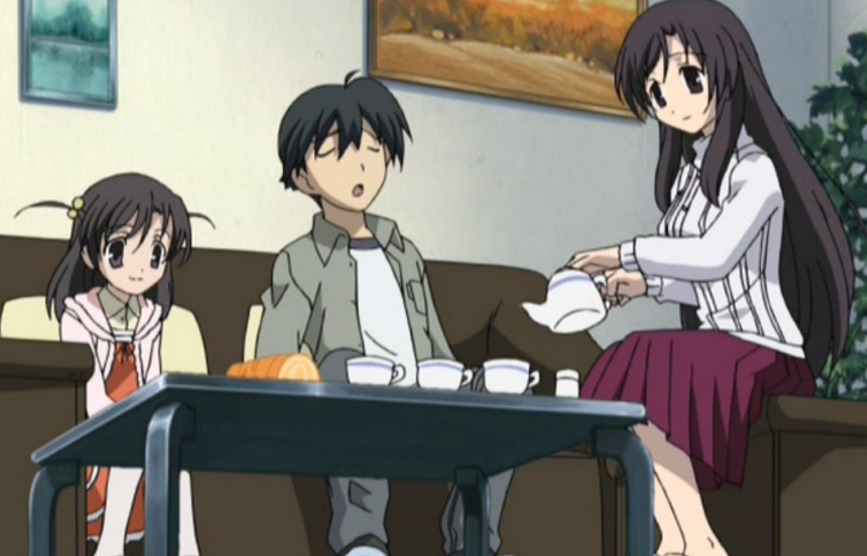
Where did Makoto turn into a deviant? There seemed to be two factors in the anime – without considering external visual novel lore. Firstly, Sekai betrayed her interest in him – meaning he had a willing fallback option. Secondly, he and Kotonoha did not have great rapport – even on their good date – and he could not be bothered to put effort into it, his lacking a soul and all.
Makoto’s initial decision to cheat on Kotonoha, and Sekai’s amenability to it, were believable enough – although Makoto’s boldness with Sekai after his initial hesitance about even talking to Kotonoha was a bit of a stretch.
The show’s logic began to collapse with Kotonoha’s descent into madness. There was no explanation for how Kotonoha went from almost breaking up with Makoto after their first date to becoming obsessed with him to the exclusion of all else. Barely anything notable happened in their relationship other than Makoto’s moving too fast for Kotonoha’s comfort.
That Kotohona had psychological issues does not save her character. They remain a mystery to me, and I am not sure that they were known to School Days’s writers either.
Had the show given a credible account of Kotohona and paced her deterioration, there could have been some merit in her story. Unfortunately, School Days’s failure to provide a believable account of Kotohona’s descent into madness was one of its fatal flaws.
On the Subject of Makoto and Sekai
Makoto, perhaps the most wretched character in anime, went from a somewhat timid ordinary high school student into an avatar of avaricious debauchery. While his transformation was better accounted for than Kotonoha’s or Sekai’s, it was not particularly convincing either. He displayed little interest in even keeping Kotonoha as an option from episode 4 through episode 10. For that reason, it was unclear why he refused to simply break up with her other than the show’s needing him to be a waffling coward. He had some aversion to letting people down to their face, but given how freely and knowingly he hurt Kotohona and Sekai, the show needed to account for why. His refusal to end things with Sekai was less troublesome in a technical sense in light of their physical relationship. But his relationship with Kotonoha was not adequately explained.
As for Makoto’s progressing into greater and greater depravity, it seems that every time a new girl became available to him, he lost interest in the previous girl. Knowing that he had Sekai in reserve made him impatient with Kotonoha, and Otome’s interest in him at the festival made him lose interest in Sekai. His night with Setsuna followed by Setsuna’s leaving seemed to flip another switch for even more lecherous behavior, but the show did not do much to explain the effect that Setsuna had on Makoto.
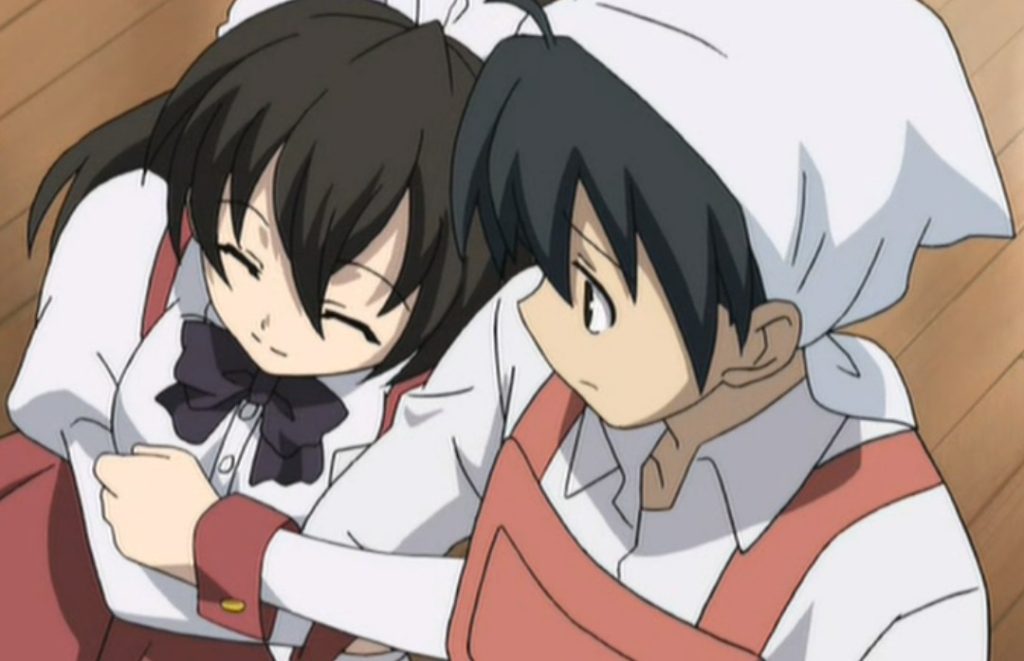
Regarding Sekai, the show never gave a compelling reason for why she became so obsessed with Makoto as to lie about being pregnant (it appears) – in light of the fact that she did so not for revenge but to force Makoto to stay with her. I have no issue with her liking Makoto at the start or her betraying Kotonoha in a technical sense. What is unexplained is why she went through such great lengths for Makoto even after he refused to break up with Kotohona, slept with an unrelated girl, and began engaging in carnal relations with nearly every girl she knew. Sekai’s character was not well-developed enough to make her obsession with Makoto believable.
On the Subject of Setsuna
Victor and I had a friend in the past who Victor referenced in a different story. This friend watched School Days as well and argued that the show was intelligent and well done. To be sure, I actually took his opinions on anime seriously – I credit him with making me consider more carefully a key point in my favorite movie, 5 Centimeters Per Second. With that being said, I could not agree with him that School Days was actually redeemable. It is not impossible to do what School Days set out to do well, but for reasons I noted above, School Days failed in doing so.
I have seen a few pro-School Days arguments – all of which were unconvincing. My friend made the most compelling case I saw – although I still found it unpersuasive.
My friend’s pro-School Days argument centered in part on Setsuna – who was his favorite character. I will recite it as best as I remember below.
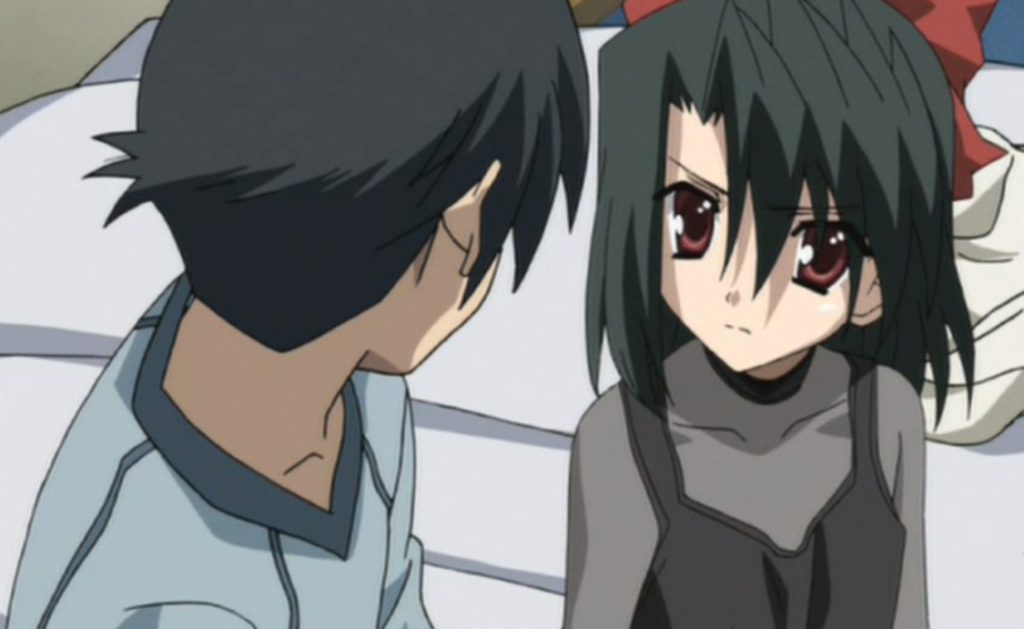
Flawed as they were, Setsuna’s actions, and ultimate failings, were coherent. She had an origin story for liking Makoto. Her decision to help Sekai made sense in light of her friendship with Sekai. Setsuna’s actions toward Kotohona, while poor, were explained in that the show gave an account of Setsuna’s understanding of the situation. Her ultimately betrayal of Sekai was also explained well. Her having to admit her feelings in order to force Kotohona to accept Makoto’s rejection – and the predictably bad consequences that ensued – was probably the closest thing School Days had to a clever moment.
In a vacuum, Setsuna’s behavior made sense. However, her behavior was in response to the poorly-explained behavior of the main trio and thus overwhelmed by the larger flaws in School Days’s story.
Where School Days Failed
Having noted how School Days failed, I will address why I think it failed.
School Days started from the conclusion of wanting to depict one of the visual novel’s “shock” endings – never mind that most people watching the show in Japan would have already been aware of the source material’s reputation.
Whether it was the fault of the source material, the anime team, or only having 12 episodes to work with, School Days did not come close to building a case over the course of its first 11 episodes for the infamous ending in episode 12. The development and behavior of the three main characters began to unambiguously defy credibility in the fifth episode. Working from a foundation of sand, the dark plot developments became more and more incredible.
School Days plowed through logic, reason, taste, and competent pacing to get from point A to point B in 12 episodes. The characters behaved and progressed in forced ways as they forged their path to bloodshed. Whenever a character needed to be in the wrong place at the right time to make the overall situation just a bit worse, he or she always made it there.
Creating Irredeemable Characters
In committing to the “bad end,” School Days set out to ensure that no one watching would feel the least bit of sympathy for Makoto. The goal was to make Makoto so irredeemably atrocious that Sekai’s murdering him would come as a relief to viewers. I will venture that they intended to do this to an extent with Sekai as well, although her wretchedness was generally dwarfed by Makoto’s.
Kotohona, as the lone survivor of the trio and ultimate “winner” of Makoto’s affections – was perhaps supposed to be sympathetic. She was kind and innocent at the start of the show – especially when compared to Makoto and Sekai (even before their darker turns). However, having Kotonoha suddenly go insane with love for Makoto after having been relatively ordinary came off as forced (to be charitable) and accidental comedy (more accurate). I have my suspicion that they included the completely unnecessary event where a lifeless Kotonoha was raped by one of the few people in the show who was arguably more horrible than Makoto out of fear that they had failed in convincing viewers that Kotonoha was supposed to be sympathetic.
Makoto was evil. Sekai was marginally less bad than Makoto. Kotonoha was a caricature.
I do agree with the assessment I noted before that Setsuna was the only character whose conflicts and actions made sense. But she was ultimately swept along with the nonsensical events of School Days.
The end result is that the show failed to make a case for genuinely caring about any of the main characters.
Final Review Thoughts
If the goal was to make School Days a decent anime, the team likely made a mistake in adapting one of its “bad” endings.
From the bit I have read about the broader series that School Days is a part of, I have my doubts that the source material in the visual novels would have supported a genuinely good anime adaptation regardless of which route they chose to adapt. With that being said, however, I will venture that had the anime team made some different choices, the result could have been a better – albeit more innocuous – anime about generally unlikeable characters making questionable life choices, without the forced bloodshed at the end.
Or as my friend would have suggested – perhaps the adaptation should have been Setsuna-centric.
(For the record – if any anime studios in Japan happen to read this, let it be said that I was not making a suggestion.)
Explaining the School Days Nice Boat Meme
Having seen School Days – the goal was to create waves with a shockingly bad ending. In that respect, School Days succeeded. It is more well-known and remembered than many better shows that were released in 2007 and surrounding years.
Of course, the reason why School Days is remembered is not for the bad ending itself, but for its bad ending being turned into a meme due to circumstances external to the show. I now transition to the story of the Nice Boat meme.
How I Learned About the Nice Boat Meme
In 2009, I began playing a video game called Persona 3 FES. Persona 3, much like its sequel Persona 4, has what are called “social links”. I was looking up something or other about one of Persona 3’s in-game social links, Chihiro Fushimi. In so doing, I stumbled on a forum post that compared her to a certain character from an anime with a notorious Nice Boat ending. In hindsight, the poster was comparing her to Kotonoha.
For the record, I submit that Chihiro was not insane. The poster was making a joke about one or two scenes where Chihiro comes off as a bit possessive. There is no sign in Persona 3 that she is capable of a Kotonoha-style meltdown.
In any event, I did not look into the issue further – but I remembered what I read about the Nice Boat ending.
A couple years later – probably in 2011 or 2012 – I noticed an anime called School Days on Crunchyroll that I had ignored before. Neither the series thumbnail nor description on Crunchyroll suggests that School Days is anything more than a mediocre (at best) mid-2000s visual novel adaptation. Something about it made me suspect that this was the infamous Nice Boat anime. I forget what made me think that it was the culprit, but having nothing better to do (philosophy majors had no homework), I decided to get to the bottom of the situation.
Only now can I recoup those hours of my life.
The Nice Boat
The day before the final bloody episode of School Days was set to air in Japan, there was a real-world incident wherein in a high school girl in Japan murdered her father with an axe. This was a bit too close to the ending of School Days for the comfort of the TV station airing School Days.
(Victor was right – the themes of Love Henry really are universal.)
The final episode of School Days was delayed for a week on account of the real-world murder becoming national news in Japan. One week later, the final episode was still not aired. It was instead replaced with a slideshow of pleasant images.
One of those pleasant images was a very nice boat sailing in Norway.
Here is the video of the nice boat.
Below, you will find a picture of the Nice Boat meme.

How did the Nice Boat become a meme?
First, including a boat in the pleasant image slideshow was ironic in light of Kotohona spending the final scene of School Days on a similar-looking boat.
Second, it was 4-Chan’s fault. One could have guessed without my saying so.
The final episode of School Days did end up airing shortly after it was initially cancelled. In the currently available version of School Days for streaming, the blood in the final episode was changed from red to black. Thus, we learned that Makoto and Sekai were robots. The jury is still out on Kotonoha.
May 7, 2022 Update: I published a new article with more information about the “Nice Boat” replacement show, including a full link to the episode.
How Victor V. Gurbo’s Question Inspired This Review
At some point a long time ago, I had told Victor the general outline of School Days. Recalling what I had told him, he asked me for the name of the show to include in his Love Henry article. While I do not remember the exact wording of his question, it was on-the-nose enough for me to identify the show that he was asking about.
The Story of Love Henry
I noted in the introduction that I was inspired to write this post by a question that Victor V. Gurbo asked me in May 2020. Specifically, Victor asked me of the name of a certain anime (referencing School Days) so he could include it in his own article on Love Henry. Why did Victor want to include a reference to a meme of an anime series that he had never seen in his article about a beloved folk ballad? He used the reference to highlight the fact that the themes in Love Henry are universal and easy to find in many types of art, old and new. Before examining the themes however, let us look at the story of Love Henry.
To begin, he described the story of Love Henry in a succinct manner:
- The protagonist’s lover tells her that he is in love with another woman.
- The protagonist convinces her lover to stay with her throughout the night.
- The protagonist then murders her lover.
Different versions of Love Henry have different accounts of the aftermath of the murder. Victor noted that in most versions, the protagonist throws her lover’s body in a river. In another, the protagonist is discovered and executed. In most versions, the protagonist believes that her pet bird will inform others of her crimes. To be sure, the story is not exactly the same as the nice boat ending of School Days, but the substantial similarities are clear.
The Universal Theme of Love Henry
Victor concluded his article by arguing that the central theme in all the versions of Love Henry is timeless:
The themes explored in Love Henry and all of its versions are timeless. From older works such as Shakespeare’s “Macbeth” and Edgar Allen Poe’s “The Tell Tale Heart,” to contemporary works such as James Dearden’s “Fatal Attraction” and the infamous Japanese anime “School Days,” artists have always and will continue to explore personal madness deriving from murders and scorned lovers.
Victor V. Gurbo (Emphasis added)
School Days found itself in lofty company there.
While I am loath to ordinarily put School Days in the same sentence as Macbeth and The Tell Tale Heart, Victor’s use of it in this context was accurate. School Days is very much about scorned lovers going mad. Its second half is rather mono-focused on that theme.
Final Thoughts
Although School Days the anime is certainly not a good show, Victor was not wrong to list it as an example of media that depict lovers descending into madness. In particular, both Kotonoha and Sekai descended into madness over Makoto – the former due to some unspecified psychological issues, and the latter on account of her not being able to take Makoto’s duplicity and rejection any longer.
With that being said, I do not think of School Days first as an artistic depiction of a timeless idea.
Like most people, I think of School Days as a meme.
The events that led to School Days becoming a meme would sound more forced than School Days’s forced march to its disastrous ending if we did not know that they actually happened. Not only did a high school student murder her father with an axe on the eve of the final episode of School Days’s original air date, but the final episode was also replaced, in part, with an image of a boat of all things.
That is the stuff of legends. The creators of School Days could not have written something that convenient if they had tried. Let it be said that they did try.
Thanks in part to its own absurdity, and in larger part to external events, School Days achieved immortality not because of its being an instantiation of the tragic idea depicted in song in Love Henry, but rather because it transcended the confines of anime and transmogrified into a meme.
Unlike Makoto and Sekai, School Days lives on.
Or to be more accurate – the Nice Boat sails on.